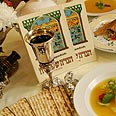
Where is Miriam on the Seder plate?
Yael Levine reintroduces the practice of commemorating Miriam by placing fish on the seder plate, and several other traditional Passover rituals that honor women
The result has been several new rituals, which continue to gain acceptance and popularity. It turns out, however, that our contemporaries were not the first generation to look for a way to bring to the Seder table the role of women in Israel's redemption.
Fishy seder
After looking at some of the texts used centuries ago, it is clear that what we call the "traditional" Seder indeed has something fishy about it. What's fishy is a missing person, a missing ritual, and actually, some missing fish.
For many years, the Seder was a time when Miriam, and the achievements of women, were memorialized. The most basic practice was a piece of fish placed on the Seder plate to commemorate Miriam.
We have two cooked foods on the seder table – an egg and a shank bone. The Talmud explains this as reflecting the holiday's two sacrifices, the special Paschal lamb and the general holiday offering.
It turns out, however, that the number of dishes at the seder wasn't fixed.
Medieval seder plate
Rabbi Sherira Gaon of 10th-century Babylon noted a custom of putting three foods on the plate.
"Those three cooked foods are fish, meat, and an egg corresponding to the foods that Israel will eat in the Time to Come; fish corresponding to Leviathan, egg to Ziz (an enormous mythic and fabulous bird), meat corresponding to wild bull."
The foods symbolize the mythic creatures from the realms of sea, air and land that will be eaten at the Meal of the Righteous in the Messianic times.
A second reason offered by R. Sherira , however, is one that resonates more strongly with our generation: "There are those who put an additional cooked food in memory ofMiriam, as it says, "And I sent before you Moses, and Aaron, and Miriam" (Micah 6, 4).
According to this, Miriam and the role she fulfilled in the redemption from Egypt is represented by the third cooked food on the seder table.
Worthwhile tradition
This tradition is worthy of renewal in our time, in recognition of the crucial role Miriam and the righteous women in Egypt played in the Exodus. Writing a millennium ago, R. Sherira was noting a then-living custom. Now, with only his text to guide us, how should we reinstitute it?
Rabbi Hayyim Palache (1788-1869) recommended we say a prayer when eating the fish at the meal, to express the hope that one will merit eating from the banquet of the Leviathan. This prayer would seem appropriate for recitation to connect to the memory of Miriam as well.
Since the shank-bone and egg retain their natural form, it would seem that a fish added to the seder plate should be baked, cooked, or smoked fish, rather than our chopped gefilte fish. It would also appear that a whole fish with head and tail intact should be used, much as many customs call for use of an entire neck and a whole egg.
In order to explain the reason for the additional foods at the seder. It would seem that since, according to R. Sherira, the Leviathan corresponds to the fish and the fish represents Miriam, verses about both the Leviathan and Miriam are suitable to be recited.
Rabbi Grate
Another rabbi cognizant of the importance of women to the Passover story was Rabbi Abraham Grate of Prague. His 1708 Haggadah commentary explained several seder rituals, including the initial hand washing, as referring to Pharaoh's daughter Bitya and her rescue of Moses from the Nile.
Several traditional sources have drawn a connection between the four cups of wine that punctuate the Seder and the four matriarchs, Sarah, Rebecca, Rachel, and Leah.
Women and haroset
And if these proto-feminist commentaries are from relatively forgotten sources, how to explain the fact that a basic interpretation of haroset revolves around women – and almost nobody knows it?
According to the Talmud, haroset is in memory of the apple tree, and Rashi in his commentary makes reference to a midrash in which, the women would go to their working husbands and would conceive children between the fields. When the women were ready to give birth, they would leave their homes out of fear of the Egyptians. They would lie underneath the apple trees and give birth. Apple haroset, then, is about the fact that the Jewish women did not lose hope in those difficult times.
Rituals, even time-honored rituals like the Seder -- can make room for change rooted in traditional sources -- in fact, these "changes" are in fact historical corrections bringing the women's voice back in after it was somehow dropped.
As the haggadah itself reminds us, the more one expounds on the Exodus the more one is to be praised. In reviving these authentic and authoritative Seder rituals commemorating the role of our Jewish foremothers, we can more fully tell of the going out from Egypt.
Yael Levine holds a Ph.D. from the Talmud department of Bar-Ilan University
Edah is the advocacy movement for a modern and relevant Orthodox Judaism










